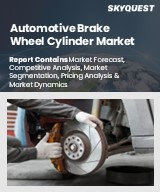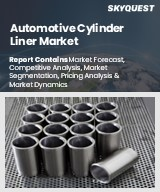
|
시장보고서
상품코드
1639221
중형 엔진 시장 기회, 성장 촉진요인, 산업 동향 분석, 예측(2025-2034년)Medium-duty Engine Market Opportunity, Growth Drivers, Industry Trend Analysis, and Forecast 2025 - 2034 |
||||||
세계 중형 엔진 시장은 2024년에 92억 달러로 평가되었으며, 2025년부터 2034년까지 연평균 복합 성장률(CAGR) 6.4%로 성장할 것으로 예측됩니다.
이 성장은 전자상거래의 급증으로 효율적인 라스트마일 배송 차량 수요가 높아진 것이 주요 요인입니다. 중형 트럭은 특히 도시의 루트에 적합하며, 혼잡한 시가지를 이동하기 위해서는 적재량과 조종성의 균형이 중요합니다.
온라인 쇼핑의 상승과 도시형 완성 센터의 확장은 성능과 효율성을 모두 제공하는 중형 엔진의 필요성에 더욱 박차를 가하고 있습니다. 이러한 엔진은 연비 효율을 유지하면서 단거리 배송에 필요한 전력을 제공함으로써 물류 업무를 지원하도록 설계되었습니다.
지속가능성은 시장을 형성하는 또 다른 중요한 요소입니다. 정부와 기업이 보다 친환경 기술을 선호하는 가운데, 각 제조업체는 저배출 가스로 연비가 좋은 중형 엔진을 개발하고 있습니다. 유럽의 유로 6 기준과 다른 지역의 유사한 정책과 같은 규제 프레임 워크는 하이브리드 및 저 배출 가스 엔진 기술의 진보를 뒷받침하고 있습니다. 친환경 솔루션을 추진함으로써 기업은 환경 목표를 달성하고 이산화탄소 배출량을 줄이기 위해 보다 깨끗한 엔진을 채택하게 되었습니다.
| 시장 범위 | |
|---|---|
| 시작연도 | 2024 |
| 예측연도 | 2025-2034 |
| 시작금액 | 92억 달러 |
| 예측 금액 | 169억 달러 |
| CAGR | 6.4% |
차량 분류에서 시장은 클래스 4, 클래스 5, 클래스 6으로 나뉩니다. 6등급 차량은 2024년 시장 점유율의 60% 이상을 차지하고, 2034년에는 95억 달러 이상에 달할 것으로 예측됩니다. 연비 효율을 높이고 적재량을 극대화하기 위해, 제조업체 각 사는 클래스 6 차량에 알루미늄이나 복합재와 같은 경량 소재를 사용하게 되어 있습니다. 이러한 기술 혁신은 화물칸 공간이 개선될 뿐만 아니라 전동 파워트레인의 중량도 상쇄되어 환경 성능과 운용상의 실용성의 밸런스가 확보됩니다.
클래스 6 차량의 모듈형 설계는 유연성과 사용자 정의성을 향상시켜 다양한 산업의 요구에 부응할 수 있습니다. 확장 가능한 플랫폼을 통해 제조업체는 다양한 바디 스타일, 파워트레인 구성 및 특수 장비를 제공할 수 있으며 이러한 차량을 다양한 용도에 적용 할 수 있습니다.
시장은 마력에 따라 150마력 미만, 150-250마력, 250마력 이상으로 구분됩니다. 150-250마력의 카테고리는 보다 깨끗한 연소와 대체 연료 파워트레인 수요에 견인되어 2034년까지 30억 달러 이상에 달할 것으로 예상되고 있습니다. 엔진, 변속기 및 기타 구성 요소를 결합한 통합 파워트레인 시스템은 신뢰성과 효율성으로 인해 인기가 높아지고 있습니다.
지역별로 중국은 2024년 시장을 석권해 세계 매출의 30% 이상을 차지하고 있습니다. 중국 제조업체는 현지 생산에 주력해 국내 사정에 최적화한 엔진을 개발하고 있습니다. 한편, 북미 제조업체는 성능과 연비를 유지하면서 엄격한 배출가스 규제에 대응하기 위해 클린 디젤 기술에 투자하고 있습니다.
목차
제1장 조사 방법과 조사 범위
제2장 주요 요약
제3장 업계 인사이트
- 생태계 분석
- 공급자의 상황
- 부품 제조업체
- 자동차 OEM
- Tier 1 공급업체
- 기술 통합업체
- 최종 사용자
- 이익률 분석
- 코스트 내역 분석
- 원재료비
- 제조 비용
- 연구개발비
- 이익률과 제경비
- 기타
- 주요 뉴스와 대처
- 기술 혁신의 상황
- 규제 상황
- 영향요인
- 성장 촉진요인
- 라스트마일 배송에서 중형차 수요 증가
- 엔진 효율의 기술 발전
- 차량 근대화 수요 증가
- 엔진의 지속가능성에 대한 주목 증가
- 업계의 잠재적 위험 및 과제
- 대체 파워트레인의 채용
- 원재료 가격 변동
- 성장 촉진요인
- 성장 가능성 분석
- Porter's Five Forces 분석
- PESTEL 분석
제4장 경쟁 구도
- 소개
- 기업 점유율 분석
- 경쟁 포지셔닝 매트릭스
- 전략 전망 매트릭스
제5장 시장 추정 및 예측 : 차량 클래스별, 2021년-2034년
- 주요 동향
- 클래스 4
- 클래스 5
- 클래스 6
제6장 시장 추정 및 예측 : 마력별, 2021년-2034년
- 주요 동향
- 150 HP 미만
- 150 HP-250 HP
- 250 HP 이상
제7장 시장 추정 및 예측 : 판매 채널별, 2021년-2034년
- 주요 동향
- OEM
- 애프터마켓
제8장 시장 추정 및 예측: 최종 용도별, 2021년-2034년
- 주요 동향
- 건설기계
- 농업기계
- 상용차
- 특수 차량
제9장 시장 추정 및 예측 : 지역별, 2021년-2032년
- 주요 동향
- 북미
- 미국
- 캐나다
- 유럽
- 영국
- 독일
- 프랑스
- 스페인
- 이탈리아
- 러시아
- 북유럽
- 아시아태평양
- 중국
- 인도
- 일본
- 한국
- 뉴질랜드
- 동남아시아
- 라틴아메리카
- 브라질
- 멕시코
- 아르헨티나
- 중동 및 아프리카
- UAE
- 남아프리카
- 사우디아라비아
제10장 기업 프로파일
- CNH Industrial
- Cummins
- Deutz AG
- Dongfeng
- Eicher Motors
- FAW Group
- Ford Motors
- Foton Motor
- General Motors
- Hino Motors
- 현대
- Isuzu Motors
- JAC Motors
- MAN Trucks & Bus
- Mercedes Benz Group(Former Daimler)
- Mitsubishi
- Navistar International(International Trucks)
- PACCAR
- Perkins Engine
- Scania
- Volvo Group
The Global Medium-Duty Engine Market, valued at USD 9.2 billion in 2024, is anticipated to grow at a compound annual growth rate (CAGR) of 6.4% from 2025 to 2034. This growth is largely driven by the surge in e-commerce, which has increased the demand for efficient last-mile delivery vehicles. Medium-duty trucks are particularly suited for urban routes, where balancing payload capacity and maneuverability is critical for navigating congested city streets.
The rise of online shopping and the expansion of urban fulfillment centers have further fueled the need for medium-duty engines that deliver both performance and efficiency. These engines are designed to support logistics operations by offering the power required for short-distance deliveries while maintaining fuel efficiency.
Sustainability is another significant factor shaping the market. As governments and corporations prioritize greener technologies, manufacturers are developing medium-duty engines with lower emissions and improved fuel efficiency. Regulatory frameworks such as the Euro 6 standards in Europe and similar policies in other regions drive advancements in hybrid and low-emission engine technologies. The push for eco-friendly solutions prompts companies to adopt cleaner engines to meet their environmental goals and reduce their carbon footprint.
| Market Scope | |
|---|---|
| Start Year | 2024 |
| Forecast Year | 2025-2034 |
| Start Value | $9.2 Billion |
| Forecast Value | $16.9 Billion |
| CAGR | 6.4% |
In terms of vehicle classification, the market is divided into Class 4, Class 5, and Class 6 vehicles. Class 6 vehicles held over 60% of the market share in 2024 and are projected to surpass USD 9.5 billion by 2034. To enhance fuel efficiency and maximize payload capacity, manufacturers increasingly use lightweight materials like aluminum and composites in Class 6 vehicles. These innovations not only improve cargo space but also offset the weight of electric powertrains, ensuring a balance between environmental performance and operational utility.
The modular design of Class 6 vehicles allows for greater flexibility and customization, catering to diverse industry needs. Scalable platforms enable manufacturers to offer various body styles, powertrain configurations, and specialized equipment, making these vehicles adaptable for different applications.
Based on horsepower, the market is segmented into engines below 150 HP, 150-250 HP, and above 250 HP. The 150-250 HP category is expected to exceed USD 3 billion by 2034, driven by the demand for cleaner combustion and alternative fuel powertrains. Integrated powertrain systems that combine engines, transmissions, and other components are becoming increasingly popular for their enhanced reliability and efficiency.
Regionally, China dominated the market in 2024, contributing over 30% of the global revenue. Chinese manufacturers are focusing on localized production and developing engines optimized for domestic conditions. Meanwhile, North American manufacturers are investing in clean diesel technologies to comply with stringent emissions regulations while maintaining performance and fuel efficiency.
Table of Contents
Chapter 1 Methodology & Scope
- 1.1 Research design
- 1.1.1 Research approach
- 1.1.2 Data collection methods
- 1.2 Base estimates and calculations
- 1.2.1 Base year calculation
- 1.2.2 Key trends for market estimates
- 1.3 Forecast model
- 1.4 Primary research & validation
- 1.4.1 Primary sources
- 1.4.2 Data mining sources
- 1.5 Market definitions
Chapter 2 Executive Summary
- 2.1 Industry 360° synopsis, 2021 - 2034
Chapter 3 Industry Insights
- 3.1 Industry ecosystem analysis
- 3.2 Supplier landscape
- 3.2.1 Component manufacturers
- 3.2.2 Automotive OEMs
- 3.2.3 Tier 1 Suppliers
- 3.2.4 Technology integrators
- 3.2.5 End users
- 3.3 Profit margin analysis
- 3.4 Cost breakdown analysis
- 3.4.1 Raw material cost
- 3.4.2 Manufacturing costs
- 3.4.3 R & D cost
- 3.4.4 Profit margins and overheads
- 3.4.5 Others
- 3.5 Key news & initiatives
- 3.6 Technology and innovation landscape
- 3.7 Regulatory landscape
- 3.8 Impact forces
- 3.8.1 Growth drivers
- 3.8.1.1 Rising demand for medium-duty vehicles in last-mile delivery
- 3.8.1.2 Technology advancements in engine efficiency
- 3.8.1.3 Growing demand for fleet modernization
- 3.8.1.4 Increasing focus on engine sustainability
- 3.8.2 Industry pitfalls & challenges
- 3.8.2.1 Adoption of alternate powertrains
- 3.8.2.2 Fluctuating raw material prices
- 3.8.1 Growth drivers
- 3.9 Growth potential analysis
- 3.10 Porter's analysis
- 3.11 PESTEL analysis
Chapter 4 Competitive Landscape, 2024
- 4.1 Introduction
- 4.2 Company market share analysis
- 4.3 Competitive positioning matrix
- 4.4 Strategic outlook matrix
Chapter 5 Market Estimates & Forecast, By Vehicle Class, 2021 - 2034 ($Bn, Units)
- 5.1 Key trends
- 5.2 Class 4
- 5.3 Class 5
- 5.4 Class 6
Chapter 6 Market Estimates & Forecast, By Horsepower, 2021 - 2034 ($Bn, Units)
- 6.1 Key trends
- 6.2 Below 150 HP
- 6.3 150 HP- 250 HP
- 6.4 Above 250 HP
Chapter 7 Market Estimates & Forecast, By Sales Channel, 2021 - 2034 ($Bn, Units)
- 7.1 Key trends
- 7.2 OEM
- 7.3 Aftermarket
Chapter 8 Market Estimates & Forecast, By End Use, 2021 - 2034 ($Bn, Units)
- 8.1 Key trends
- 8.2 Construction machinery
- 8.3 Agricultural machinery
- 8.4 Commercial vehicles
- 8.5 Special vehicles
Chapter 9 Market Estimates & Forecast, By Region, 2021 - 2032 ($Bn, Units)
- 9.1 Key trends
- 9.2 North America
- 9.2.1 U.S.
- 9.2.2 Canada
- 9.3 Europe
- 9.3.1 UK
- 9.3.2 Germany
- 9.3.3 France
- 9.3.4 Spain
- 9.3.5 Italy
- 9.3.6 Russia
- 9.3.7 Nordics
- 9.4 Asia Pacific
- 9.4.1 China
- 9.4.2 India
- 9.4.3 Japan
- 9.4.4 South Korea
- 9.4.5 ANZ
- 9.4.6 Southeast Asia
- 9.5 Latin America
- 9.5.1 Brazil
- 9.5.2 Mexico
- 9.5.3 Argentina
- 9.6 MEA
- 9.6.1 UAE
- 9.6.2 South Africa
- 9.6.3 Saudi Arabia
Chapter 10 Company Profiles
- 10.1 CNH Industrial
- 10.2 Cummins
- 10.3 Deutz AG
- 10.4 Dongfeng
- 10.5 Eicher Motors
- 10.6 FAW Group
- 10.7 Ford Motors
- 10.8 Foton Motor
- 10.9 General Motors
- 10.10 Hino Motors
- 10.11 Hyundai
- 10.12 Isuzu Motors
- 10.13 JAC Motors
- 10.14 MAN Trucks & Bus
- 10.15 Mercedes Benz Group (Former Daimler)
- 10.16 Mitsubishi
- 10.17 Navistar International (International Trucks)
- 10.18 PACCAR
- 10.19 Perkins Engine
- 10.20 Scania
- 10.21 Volvo Group



















